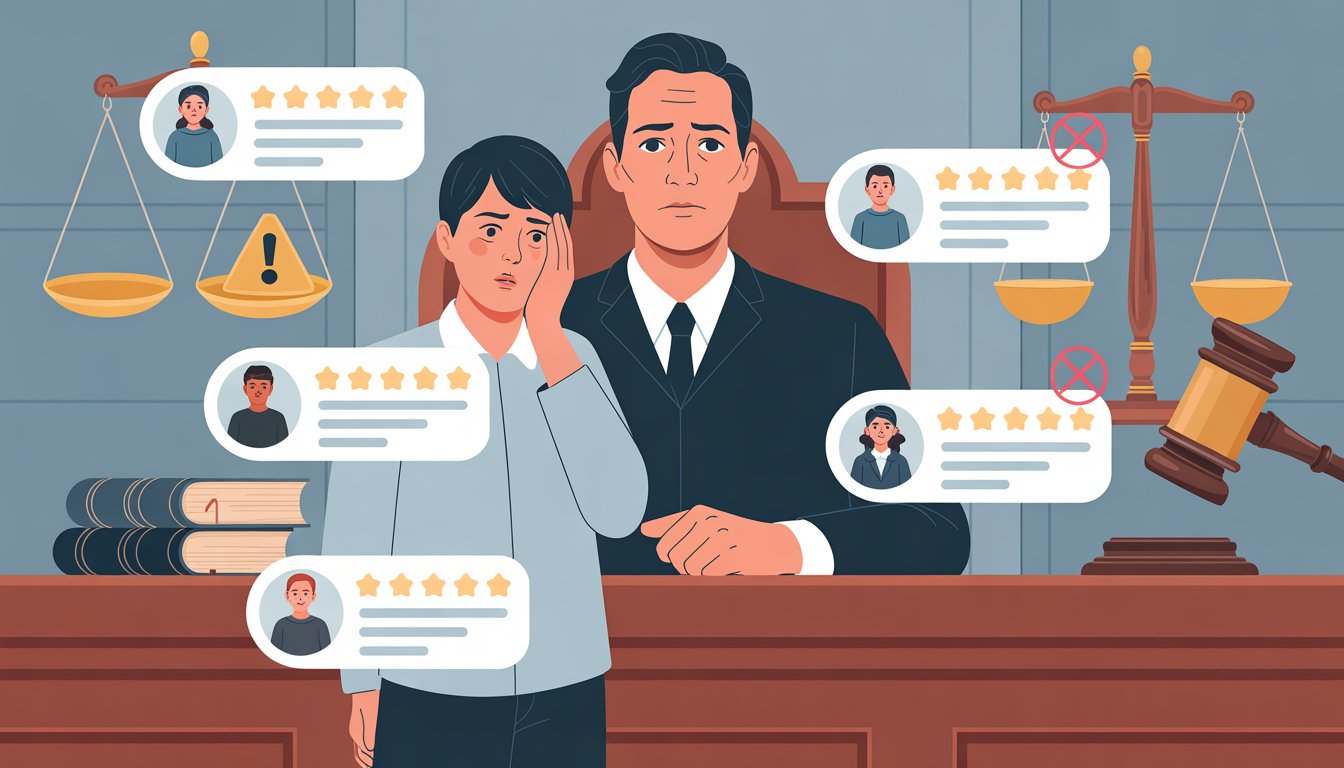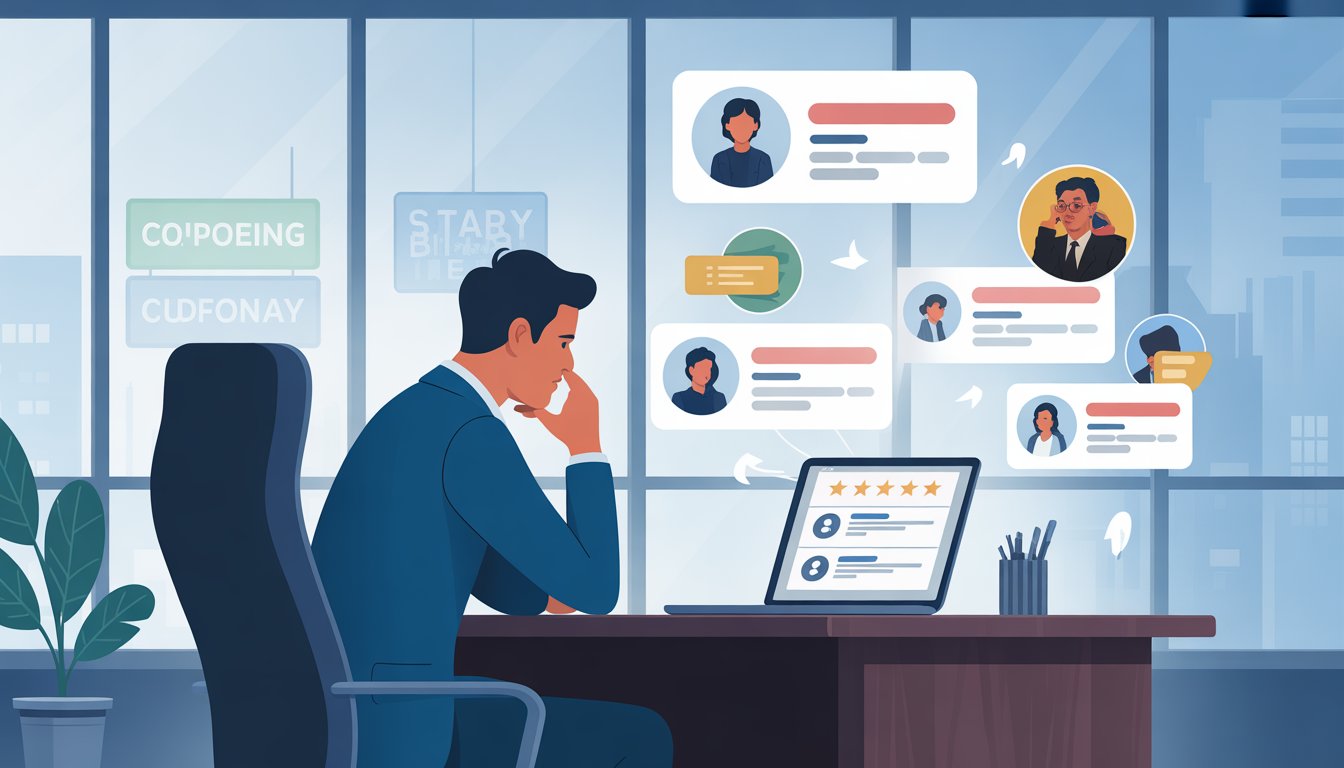Negative reviews feel like a punch to the gut for most business owners. Your first reaction might be to ignore them, fire back with anger, or craft a quick generic response to make the problem disappear.
But here's the truth that could save your reputation.

The biggest mistake businesses make when responding to negative reviews is ignoring them completely. When you stay silent, potential customers see it as proof that you don't care about problems or feedback.
Every ignored review sends a message that customer satisfaction isn't your priority. Your response to criticism says more about your business than the original complaint ever could.
Smart businesses know that negative reviews aren't disasters. They're chances to show how you handle problems and treat customers when things go wrong.
Key Takeaways
- Ignoring negative reviews makes your business look careless and unprofessional to future customers.
- How you respond to complaints reveals your true commitment to customer service and problem-solving.
- Negative feedback gives you valuable opportunities to improve your business and win back trust.
Understanding the Impact of Negative Reviews

Negative reviews can significantly damage your business reputation and reduce potential sales. Customer feedback spreads quickly online and influences how future customers view your brand.
How Negative Reviews Influence Brand Perception
One negative review can create a lasting impression on potential customers. Studies show that a single bad review can deter multiple people from choosing your business.
Mobile apps with ratings of 3 stars or lower see major drops in downloads. Customers often view these ratings as red flags.
Negative reviews carry more weight than positive ones in customer minds. People tend to focus on problems rather than praise when making decisions.
Your brand reputation depends heavily on how others perceive your business online. Even one unaddressed complaint can trigger more negative comments from other customers.
The snowball effect happens when ignored reviews lead to more criticism. This creates an avalanche of bad press that becomes harder to control.
The Role of Online Reputation in Customer Decision-Making
Your online reputation directly affects your sales numbers. Too many negative reviews without responses can reduce customer trust and revenue.
Customers research businesses before buying products or services. They read reviews to understand what their experience might be like.
Review patterns matter more than individual complaints. Smart customers look at your overall review profile to make judgments.
If your business has mostly positive reviews, one negative review won't hurt you much. Customers understand that no business is perfect.
However, multiple negative reviews create doubt in customer minds. They start questioning whether your business can deliver quality service.
Common Sources of Negative Reviews
Customer feedback often comes from misaligned expectations between what you promise and what you deliver. Clear communication helps prevent these issues.
Poor customer service generates the most complaints. Customers expect friendly, helpful staff and quick problem resolution.
Product or service quality problems create negative reviews. Customers share their disappointment when items don't meet their needs.
Misunderstandings about policies, pricing, or procedures lead to frustrated customers. These situations often result from unclear information.
Unreasonable customers sometimes leave negative reviews despite good service. These reviews happen less often but still impact your reputation.
Technical issues like website problems or payment processing errors frustrate customers. They often blame the business for these inconveniences.
The Biggest Mistake Businesses Make: Ignoring Negative Reviews

When businesses choose to ignore negative reviews completely, they damage customer trust and miss valuable chances to improve their service. This silence creates lasting problems that hurt both current and future customers.
Why Ignoring Feedback Harms Customer Trust
Your silence sends a clear message to customers. When you don't respond to negative reviews, potential customers think you don't care about problems.
Trust breaks down in three key ways:
- Customers see your business as unresponsive
- They worry their concerns won't matter if they buy from you
- They choose competitors who actively engage with feedback
Studies show that customers expect responses to their reviews within 24-48 hours. When you stay quiet, you lose credibility fast.
New customers read your reviews before buying. They notice when complaints go unanswered.
This creates doubt about your customer service quality. Your reputation suffers more damage from ignoring reviews than from the original complaint itself.
Long-Term Consequences for Customer Satisfaction
Ignoring negative feedback creates bigger problems over time. Small issues turn into major customer satisfaction disasters when left unaddressed.
The pattern typically follows these steps:
- First complaint gets ignored
- More customers experience the same problem
- Frustration builds across your customer base
- Negative reviews multiply
- Customer satisfaction scores drop
You miss early warning signs when you don't pay attention to complaints. Problems that could be fixed easily become expensive disasters.
LG faced a $1.5 million class action lawsuit partly because they didn't respond properly to complaints about faulty refrigerator compressors. Customers felt ignored and took legal action.
When customers feel unheard, their dissatisfaction grows stronger. They tell friends and family about their bad experiences.
Lost Opportunities for Service Recovery
Every negative review gives you a chance to win back a customer. When you ignore these opportunities, you lose twice - the original customer and potential new ones.
Service recovery benefits you miss include:
- Turning angry customers into loyal advocates
- Showing other customers you care about problems
- Learning about product or service issues early
- Demonstrating your commitment to customer satisfaction
Responding to negative reviews can actually improve your reputation more than having no complaints at all. It shows you're human and willing to make things right.
You also lose valuable feedback about your business operations. Negative reviews often point out real problems you need to fix.
Other customers watch how you handle complaints. When they see you ignore problems, they worry about getting stuck with bad service too.
Other Common Errors When Responding to Negative Reviews
Beyond the biggest mistakes, businesses often fall into other traps that can damage their reputation. Getting emotional, using copy-paste responses, or making promises they can't keep are frequent missteps that hurt customer service efforts.
Responding Emotionally or Defensively
Your first reaction to a harsh review might be anger or the urge to defend your business. This natural response can lead to serious problems if you act on it.
Emotional responses make you look unprofessional. When you argue with customers or use defensive language, other potential customers see this behavior.
They wonder if you will treat them the same way. Defensive replies often make the situation worse. Instead of fixing the problem, you create a public argument.
This draws more attention to the negative review. Here are signs your response is too defensive:
- Using words like "actually," "however," or "but"
- Explaining why the customer is wrong
- Making excuses for what happened
- Questioning the customer's version of events
Take time to cool down before responding. Write your response, then wait a few hours and read it again.
Ask yourself if it sounds helpful or argumentative.
Using Generic or Canned Responses
Cookie-cutter replies might save time, but they send the wrong message to customers. People can easily spot responses that don't address their specific concerns.
Generic responses show you don't really care. When every negative review gets the same basic reply, customers think you're just going through the motions.
This makes your customer service look fake. Canned responses miss the real issues. If someone complains about dirty tables but you give a general apology about "service," you haven't shown that you understand the problem.
Your responses should include:
- Specific details from the customer's review
- Direct acknowledgment of their main complaint
- Relevant solutions that match their experience
For example, if someone complains about cold food, mention the food temperature in your response. Don't just say "we're sorry you had a bad experience."
Overpromising Solutions and Not Following Up
Making big promises in your public response can backfire if you don't deliver. Customers remember when you fail to keep your word.
Don't promise what you can't control. Saying "this will never happen again" sets you up for failure.
Instead, explain what steps you're taking to prevent similar problems. Follow through on your commitments.
If you promise to contact the customer, do it within the timeframe you mentioned. If you say you'll investigate, actually investigate.
Common overpromises to avoid:
- "We guarantee this won't happen again"
- "We'll completely change our process"
- "Every customer will be 100% satisfied"
Better approaches focus on realistic improvements:
- "We're retraining our staff on this issue"
- "We've added extra quality checks"
- "We're reviewing our procedures"
Always track your public promises and make sure someone follows up. This builds trust and shows you take customer feedback seriously.
Best Practices for Responding to Negative Reviews
Effective review responses require speed, personal attention, and genuine concern for customer problems. These three elements work together to turn unhappy customers into loyal ones.
Responding Promptly and Professionally
You should respond to negative reviews within 24 hours when possible. Quick responses show you care about customer problems and prevent negative feelings from growing worse.
Keep your tone professional even when the review seems unfair. Avoid arguing with the customer or defending your business aggressively.
Use simple, direct language that addresses their concerns. Thank them for their feedback before explaining your side of the situation.
Professional response elements:
- Polite greeting
- Thank you for the feedback
- Brief explanation or solution
- Contact information for follow-up
Stay calm even if the review makes you angry. Remember that other customers will read your response and judge your business based on how you handle criticism.
Personalizing Every Response
Never use the same response for different reviews. Customers notice when businesses copy and paste the same message to everyone.
Read each review carefully and mention specific issues the customer raised. If they complained about dirty tables, talk about your cleaning procedures.
Reference details from their experience when appropriate. This shows you actually read their review and care about their specific problem.
Key personalization tactics:
- Mention specific complaints
- Use the customer's name if available
- Reference their visit date or location
- Address their main concern directly
Generic responses make customers think you don't really care about fixing problems. Personal responses show you take each complaint seriously.
Showing Empathy and Taking Responsibility
Start your response by understanding how the customer felt. Use phrases like "I understand your frustration" or "I'm sorry this happened during your visit."
Take responsibility when your business made a mistake. Don't blame employees or make excuses for poor service.
Explain what you're doing to fix the problem. Customers want to know you'll prevent the same issue from happening again.
Empathy in action:
- Acknowledge their disappointment
- Apologize for specific problems
- Explain improvement steps
- Offer to make things right
Avoid over-apologizing when the customer was clearly wrong. You can show empathy without admitting fault for things beyond your control.
Transforming Negative Feedback into Positive Change
Smart businesses turn customer complaints into growth opportunities. When you handle negative reviews properly, you can improve your services and build stronger relationships with customers.
Learning from Criticism to Improve Offerings
Customer feedback reveals real problems in your business that you might miss otherwise. Every complaint shows you where your service falls short.
Look for patterns in negative reviews. If three customers complain about slow service, you have a clear area to fix.
If multiple people mention rude staff, you need better training. Track common issues by category:
- Service speed - wait times, delays
- Product quality - defects, performance problems
- Staff behavior - rudeness, lack of knowledge
- Pricing - value concerns, hidden fees
Use this data to make real changes. Update your training programs.
Fix product issues. Improve your processes.
Many businesses only hear from 1 in 25 unhappy customers. The ones who leave reviews give you free advice on how to get better.
Leveraging Feedback for Customer Retention
Responding well to negative reviews can win back lost customers. When you fix someone's problem, they often become more loyal than before.
Offer specific solutions in your responses:
- Refunds or credits
- Free services to make up for mistakes
- Direct contact with management
- Clear steps to prevent future problems
Studies show that customers who have a problem resolved become more loyal than those who never had issues. This happens when they see you care about fixing mistakes.
Follow up with customers after resolving their complaints. Call them or send an email to make sure they're happy with the solution.
Customer satisfaction improves when people see you take feedback seriously. Other customers reading your responses will trust you more when they see how you handle problems.
Demonstrating Commitment to Service Excellence
Your review responses show potential customers how you treat people when things go wrong. This matters more than perfect ratings.
Answer every negative review within 24-48 hours. Quick responses show you monitor feedback and care about customer experiences.
Key elements of strong responses:
- Apologize sincerely for the problem
- Address the specific issue mentioned
- Offer a clear solution
- Provide contact information for follow-up
Avoid generic responses like "We're sorry you had a bad experience." Instead, mention specific details from their review.
Train your team to see negative reviews as improvement opportunities, not attacks. This mindset shift helps everyone focus on solutions instead of feeling defensive.
Building a Customer-Centric Review Response Process
Creating a system that puts customers first helps your business respond to reviews more effectively. This approach involves training your team properly and setting up clear rules for responses.
Training Teams for Effective Review Management
Your customer service team needs specific skills to handle negative reviews well. They must learn to stay calm when facing angry customers online.
Train staff to read reviews carefully before responding. This prevents mistakes like missing the main complaint or responding to the wrong issue.
Teach your team to write responses that sound human and caring. Generic replies make customers feel ignored and hurt customer satisfaction.
Role-playing exercises help staff practice difficult situations. Have them respond to fake negative reviews during training sessions.
Key training areas include:
- Reading reviews for tone and main complaints
- Writing personal responses without revealing private customer information
- Staying professional when customers use harsh language
- Knowing when to move conversations offline
Set up regular training updates. Review response styles change over time, and your team needs to stay current with best practices.
Establishing Consistent Response Guidelines
Clear rules help your team respond to reviews the same way every time. This creates a professional image for your business.
Create response templates for common complaints, but require staff to customize each one. The template gives structure while personalization shows you care about individual customers.
Your guidelines should cover:
- Maximum response time (usually 24-48 hours)
- Required elements in every response
- Information that should never be shared publicly
- When to apologize versus when to explain your side
Set rules about what customer information can be mentioned. Never share details the customer didn't already make public in their review.
Train staff to focus on solutions rather than arguments. Your response should offer help or explain how you'll fix the problem.
Review responses before they go live when possible. A second pair of eyes catches mistakes and ensures responses match your brand voice.
Frequently Asked Questions
Business owners often struggle with specific situations when responding to negative feedback. Understanding how to handle cleanliness complaints, fake reviews, and various other challenging scenarios can protect your reputation and turn critics into customers.
How should businesses handle negative reviews about poor cleanliness?
Address cleanliness complaints directly and specifically. Reference the exact issue mentioned in the review rather than using generic responses.
Explain the immediate steps you're taking to fix the problem. For example, state "We are taking steps to ensure that the tables are cleaned thoroughly after each customer" instead of a vague apology.
Follow up with concrete actions. Share what changes you've made to prevent similar issues in the future.
What are some effective strategies for responding to negative reviews from individuals who are not actual customers?
Respond professionally without directly accusing the reviewer of being fake. Keep your tone calm and factual.
Ask for specific details about their visit or purchase. Request information like the date of service or transaction details.
Focus on your commitment to quality service. Use the opportunity to show other potential customers how you handle all feedback.
What common pitfalls should businesses avoid when replying to negative comments online?
Never respond in anger or with an argumentative tone. This gives credibility to negative reviews and makes you look unprofessional.
Avoid revealing personal information about the reviewer. Don't share details beyond what the customer already made public.
Skip the canned responses that sound identical for every review. Customers notice when replies lack genuine engagement with their specific concerns.
Don't apologize when you're not at fault. Unnecessary apologies can make you appear guilty of problems you didn't cause.
How can businesses constructively address fake or unverified negative reviews?
Respond calmly without calling the review fake directly. Ask for specific details about their experience to verify legitimacy.
Focus on your actual service standards. Use the response to highlight your commitment to customer satisfaction.
Contact the platform if you have proof the review violates their policies. Most review sites have procedures for handling fraudulent content.
Why is it important for business owners to respond to negative reviews, and how can it affect their reputation?
Responding shows you care about customer feedback and take criticism seriously. This demonstrates professionalism to future customers reading your reviews.
Your response becomes part of your public reputation. Potential customers judge businesses based on how they handle negative situations.
In what ways can responding incorrectly to negative reviews be detrimental to a business?
Angry responses can escalate situations and make you look unprofessional. This drives away potential customers who see your hostile reactions.
Revealing private customer information breaks trust. Other customers worry you might share their personal details publicly too.
Generic responses make you appear insincere. Customers question whether you actually care about their concerns when every reply sounds the same.
Focusing only on review removal sends the wrong message. Customers notice when you prioritize managing reviews over fixing actual problems.










